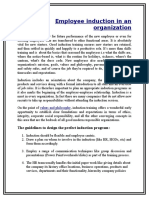Just in Time
Uploaded by
Praneit KhotJust in Time
Uploaded by
Praneit KhotJust in time (JIT) is a production strategy that strives to improve a business return on investment by reducing in-process inventory and
associated carrying costs. To meet JIT objectives, the process relies on signals or Kanban ( Kanban?) between different points in the process, which tell production when to make the next part. Kanban are usually 'tickets' but can be simple visual signals, such as the presence or absence of a part on a shelf. Implemented correctly, JIT focuses on continuous improvement and can improve a manufacturing organization's return on investment, quality, and efficiency. To achieve continuous improvement key areas of focus could be flow, employee involvement and quality. Quick notice which requires personnel to order new stock once existing stock is depleting is critical to the inventory reduction at the center of the JIT policy, which saves warehouse space and costs. However, JIT relies on other elements in the inventory chain as well. For instance, its effective application cannot be independent of other key components of a lean manufacturing system or it can "end up with the opposite of the desired result."[1] In recent years manufacturers have continued to try to hone forecasting methods such as applying a trailing 13week average as a better predictor for JIT planning;[2] however, some research demonstrates that basing JIT on the presumption of stability is inherently flawed.[3] the storage of unused inventory is a waste of resources. JIT inventory systems expose hidden cost of keeping inventory, and are therefore not a simple solution for a company to adopt. The company must follow an array of new methods to manage the consequences of the change. The ideas in this way of working come from many different disciplines including statistics, industrial engineering, production management, and behavioral science. The JIT inventory philosophy defines how inventory is viewed and how it relates to management.
Inventory is seen as incurring costs, or waste, instead of adding and storing value, contrary to traditional accounting. This does not mean to say JIT is implemented without an awareness that removing inventory exposes preexisting manufacturing issues. This way of working encourages businesses to eliminate inventory that does not compensate for manufacturing process issues, and to constantly improve those processes to require less inventory. Secondly, allowing any stock habituates management to stock keeping. Management may be tempted to keep stock to hide production problems. These problems include backups at work centers, machine reliability, process variability, lack of flexibility of employees and equipment, and inadequate capacity. In short, the Just-in-Time inventory system focus is having the right material, at the right time, at the right place, and in the exact amount-Ryan Grabosky, without the safety net of inventory. The JIT system has broad implications for implementers. Waste Reduction - Japanese car manufacturer Toyota found out that production times slow down due to some factors and their delay or lag times. They found that if these wastes or delay time factors are eliminated of their production process, they could achieve faster production times. What started as an experiment for Toyota, went on to become one of the principles of Lean Manufacturing which is even implemented by many manufacturing companies in the USA.
3) Walter Shewhart - The Grandfather of Total Quality Management. His Ideas The original notions of Total Quality Management and continuous improvement trace back to a former Bell Telephone employee named Walter Shewhart. One of W. Edwards Deming's teachers, he preached the importance of adapting management processes to create profitable situations for both businesses and consumers, promoting the utilization of his own creation -- the SPC control chart. Dr. Shewhart believed that lack of information greatly hampered the efforts of control and management processes in a production environment. In order to aid a manager in making scientific, efficient, economical decisions, he developed Statistical Process Control methods. Many of the modern ideas regarding quality owe their inspirtation to Dr. Shewhart. He also developed the Shewhart Cycle Learning and Improvement cycle, combining both creative management thinking with statistical analysis. This cycle contains four continuous steps: Plan, Do, Study and Act. These steps (commonly refered to as the PDSA cycle), Shewhart believed, ultimately lead to total quality improvement. The cycle draws its structure from the notion that constant evaluation of management practices -- as well as the willingness of management to adopt and disregard unsupported ideas --are keys to the evolution of a successful enterprise. To find out more about some of the management tools that have been developed from Shewhart and other quality pioneers, click on the SkyMark Management Tools page.
What is TQM Concept in Japan? TQM, also known as Total Quality Control (TQC), is a management tool for improving total performance. TQC means organized Kaizen activities involving everyone in a company managers and workers in a totally systemic and integrated effort toward improving performance at every level. It is to lead to increased customer satisfaction through satisfying such corporate cross-functional goals as quality, cost, scheduling, manpower development, and new product development. In Japan, TQC activities are not limited to quality control only. Elaborate system of Kaizen strategies has been developed as management tools within the TQC approach. TQC in Kaizen is a movement aimed at improvement of managerial performance at all levels. According to the Japan Industrial Standards, "implementing quality control effectively necessitates the cooperation of all people in the company, including top management, managers, supervisors, and workers in all areas of corporate activities such as market research and development, product planning, design, preparation for production, purchasing, vendor management, manufacturing, inspection, sales and after-sale services, as well as financial control, personnel administration, and training & education. Quality control carried out in this manner is called company-wide quality control or total quality control (TQC)." Quality control in Japan deals with quality of people. It is the fundamental concept of the Kaizen-style TQC. Building quality into its people brings a company a half-way towards producing quality products.
Successful Implementation of Kaizen: 7 Conditions One of the most difficult aspects of introducing and implementingKaizen strategy is assuring its continuity. When a company introduces something new, such as quality circles, or total quality management (TQM), it experiences some initial success, but soon such success disappear like fireworks on summer night and after a while nothing is left, and management keeps looking for a new flavor of the month. This if because the company lacks the first three most important conditions for the successful introduction and implementation of Kaizen strategy... More Concept of Continuous Improvement Filed under: Management of Process Quality, Structures and Teams Tags: continuous improvement, employee involvement, Kaizen, operator ownership, SPC Nameer @ 8:00 pm Continuous improvement is based on a Japanese Concept called Kaizen, is the philosophy of continually seeking ways to improve operations. It invloves identifying benchmarks of excellent practices and instilling a sense of employee ownership of the process. The focus can be on:
Reducing the length of time required to process requests for loans in bank
The amount of scrap generated at a milling machine or the number of employee injuries.
Continuous improvement can also focus on problems with customers or suppliers, such as customers who request frequent changes in shipping quantities and suppliers that to maintain high quality.
The bases of the continuous improvement philosophy are the beliefs that virtually any aspect of an operation can be improved and that the people most closely associated with an operation are in the best position to identify the changes that should be made. Consequently, employee involvement plays a big role in continuous improvement programs. Getting Started with Continuous Improvement Instilling a philosophy of continuous improvement in an organization may be a lengthy process, and several steps are essential to its eventual success. 1. Train employees in the methods of statistical process control (SPC) and other tools for improvement quality. 2. Make SPC methods a normal aspect of daily operations. 3. Build work teams and employee involvement. 4. Utilize problem-solving techniques within work teams.
5. Develop a sense of operator ownership of the process. Here employee involvement is central to the philosophy of continuous improvement. However, the last two steps are crucial if the philosophy is to be the part of everyday operations.A sense of operator ownership emerges when employees feel as if they own the processes and methods they use and take pride in the quality of product or service they produce. It comes from participation on work teams and in problem-solving activities, which instill in employees a feeling that they have some control over their workplace.
You might also like
- Gartner Cisos Guide To Your First 100 Days100% (1)Gartner Cisos Guide To Your First 100 Days21 pages
- Bottleneck Reduction at The Shoes Production Line Using Theory of Constraints ApproachNo ratings yetBottleneck Reduction at The Shoes Production Line Using Theory of Constraints Approach6 pages
- Integrated Marketing Plan of Pulse CandyNo ratings yetIntegrated Marketing Plan of Pulse Candy13 pages
- IBM Course Description - Advanced Data Warehousing Workshop - Multi-Dimensional Modeling - IBM Training - United StatesNo ratings yetIBM Course Description - Advanced Data Warehousing Workshop - Multi-Dimensional Modeling - IBM Training - United States3 pages
- Positive Externalities - Economics Help PDFNo ratings yetPositive Externalities - Economics Help PDF4 pages
- ADDIE+: Adopting Proven Practices From The IT IndustryNo ratings yetADDIE+: Adopting Proven Practices From The IT Industry7 pages
- An Evolutionary Model of Continuous Improvement Behaviour: John Bessant, Sarah Caffyn, Maeve Gallagher100% (1)An Evolutionary Model of Continuous Improvement Behaviour: John Bessant, Sarah Caffyn, Maeve Gallagher11 pages
- A Real Application of The Theory of Constraints To Supply Chain PDF100% (1)A Real Application of The Theory of Constraints To Supply Chain PDF20 pages
- Cyber Hygiene: Golden Rules of NetiquetteNo ratings yetCyber Hygiene: Golden Rules of Netiquette63 pages
- Lean Project Delivery: Glenn Ballard Project Production Systems LaboratoryNo ratings yetLean Project Delivery: Glenn Ballard Project Production Systems Laboratory95 pages
- How Procter and Gamble Survived Through Innovation - A Case StudyNo ratings yetHow Procter and Gamble Survived Through Innovation - A Case Study8 pages
- Linked To Influence 7 Powerful Rules For Becoming A Top InfluencerNo ratings yetLinked To Influence 7 Powerful Rules For Becoming A Top Influencer194 pages
- Rummler and Brache - Nine Performance Variable ModelNo ratings yetRummler and Brache - Nine Performance Variable Model16 pages
- Lean Strategy Implementation MethodologyNo ratings yetLean Strategy Implementation Methodology48 pages
- A Case Study On Identifying Software Development Lifecycle and Process FrameworkNo ratings yetA Case Study On Identifying Software Development Lifecycle and Process Framework5 pages
- Strategic Management - Session Slides - 1No ratings yetStrategic Management - Session Slides - 1120 pages
- Overview of Lean: Lean Management Program Sept 2012No ratings yetOverview of Lean: Lean Management Program Sept 201236 pages
- Rapid Mass Engagement: Driving Continuous Improvement through Employee Culture CreationFrom EverandRapid Mass Engagement: Driving Continuous Improvement through Employee Culture CreationNo ratings yet
- Business Relationship Manager Complete Self-Assessment GuideFrom EverandBusiness Relationship Manager Complete Self-Assessment GuideNo ratings yet
- Building Business Acumen for Trainers: Skills to Empower the Learning FunctionFrom EverandBuilding Business Acumen for Trainers: Skills to Empower the Learning FunctionNo ratings yet
- NZ Customs 175th Souvenir Publication - AW - Flip PDF0% (1)NZ Customs 175th Souvenir Publication - AW - Flip PDF60 pages
- Going Global - Acting Local Marketing Strategy ofNo ratings yetGoing Global - Acting Local Marketing Strategy of8 pages
- Accounting Concepts For The Actuary: by Ralph S. Blanchard III, FCAS, MAAANo ratings yetAccounting Concepts For The Actuary: by Ralph S. Blanchard III, FCAS, MAAA16 pages
- Balancing Demand and Productive CapacityNo ratings yetBalancing Demand and Productive Capacity27 pages
- Different Perspectives of Service Quality: Quality Excellence. Recognized Only Through ExperienceNo ratings yetDifferent Perspectives of Service Quality: Quality Excellence. Recognized Only Through Experience11 pages
- LearnEnglish Listening C1 A Job Interview PDFNo ratings yetLearnEnglish Listening C1 A Job Interview PDF5 pages
- ISO 45001:2018 Checklist: 4. Context of The Organisation 4.1 Understanding The Organisation and Its ContextNo ratings yetISO 45001:2018 Checklist: 4. Context of The Organisation 4.1 Understanding The Organisation and Its Context1 page
- Salesforce and Channel Management: Metric Construction Formula Considerations PurposeNo ratings yetSalesforce and Channel Management: Metric Construction Formula Considerations Purpose2 pages
- Task 5 - Canva Key Performance Indicators and Measuring HRM - CJNo ratings yetTask 5 - Canva Key Performance Indicators and Measuring HRM - CJ7 pages
- There Are Few Pros and Cons Associated With It Which Are Discussed BelowNo ratings yetThere Are Few Pros and Cons Associated With It Which Are Discussed Below1 page
- Business Process Monitoring Guide For Extended Warehouse ManagementNo ratings yetBusiness Process Monitoring Guide For Extended Warehouse Management144 pages
- Zara Rodriguez Manager: Governance Risk and ComplianceNo ratings yetZara Rodriguez Manager: Governance Risk and Compliance3 pages
- Annex SL 9001 14001 45001 Management System MapNo ratings yetAnnex SL 9001 14001 45001 Management System Map3 pages
- Case Study On Failed Implementation of ErpNo ratings yetCase Study On Failed Implementation of Erp15 pages
- Chapter - 01, Concept and Need For AssuranceNo ratings yetChapter - 01, Concept and Need For Assurance5 pages
- Botho University Eswatini Prospectus 2025No ratings yetBotho University Eswatini Prospectus 202525 pages
- Software Process Models: Chapter 2 & 3 in Software Engineering BookNo ratings yetSoftware Process Models: Chapter 2 & 3 in Software Engineering Book41 pages
- Senior Leaders: What You Need To Know About Major Hazard LeadershipNo ratings yetSenior Leaders: What You Need To Know About Major Hazard Leadership2 pages
- Investment Thesis, Platform Based Business ModelsNo ratings yetInvestment Thesis, Platform Based Business Models2 pages
- Bottleneck Reduction at The Shoes Production Line Using Theory of Constraints ApproachBottleneck Reduction at The Shoes Production Line Using Theory of Constraints Approach
- IBM Course Description - Advanced Data Warehousing Workshop - Multi-Dimensional Modeling - IBM Training - United StatesIBM Course Description - Advanced Data Warehousing Workshop - Multi-Dimensional Modeling - IBM Training - United States
- ADDIE+: Adopting Proven Practices From The IT IndustryADDIE+: Adopting Proven Practices From The IT Industry
- An Evolutionary Model of Continuous Improvement Behaviour: John Bessant, Sarah Caffyn, Maeve GallagherAn Evolutionary Model of Continuous Improvement Behaviour: John Bessant, Sarah Caffyn, Maeve Gallagher
- A Real Application of The Theory of Constraints To Supply Chain PDFA Real Application of The Theory of Constraints To Supply Chain PDF
- Lean Project Delivery: Glenn Ballard Project Production Systems LaboratoryLean Project Delivery: Glenn Ballard Project Production Systems Laboratory
- How Procter and Gamble Survived Through Innovation - A Case StudyHow Procter and Gamble Survived Through Innovation - A Case Study
- Linked To Influence 7 Powerful Rules For Becoming A Top InfluencerLinked To Influence 7 Powerful Rules For Becoming A Top Influencer
- Rummler and Brache - Nine Performance Variable ModelRummler and Brache - Nine Performance Variable Model
- A Case Study On Identifying Software Development Lifecycle and Process FrameworkA Case Study On Identifying Software Development Lifecycle and Process Framework
- Overview of Lean: Lean Management Program Sept 2012Overview of Lean: Lean Management Program Sept 2012
- Rapid Mass Engagement: Driving Continuous Improvement through Employee Culture CreationFrom EverandRapid Mass Engagement: Driving Continuous Improvement through Employee Culture Creation
- Business Relationship Manager Complete Self-Assessment GuideFrom EverandBusiness Relationship Manager Complete Self-Assessment Guide
- Reflections of My Leadership: A Leadership ManualFrom EverandReflections of My Leadership: A Leadership Manual
- Building Business Acumen for Trainers: Skills to Empower the Learning FunctionFrom EverandBuilding Business Acumen for Trainers: Skills to Empower the Learning Function
- NZ Customs 175th Souvenir Publication - AW - Flip PDFNZ Customs 175th Souvenir Publication - AW - Flip PDF
- Accounting Concepts For The Actuary: by Ralph S. Blanchard III, FCAS, MAAAAccounting Concepts For The Actuary: by Ralph S. Blanchard III, FCAS, MAAA
- Different Perspectives of Service Quality: Quality Excellence. Recognized Only Through ExperienceDifferent Perspectives of Service Quality: Quality Excellence. Recognized Only Through Experience
- ISO 45001:2018 Checklist: 4. Context of The Organisation 4.1 Understanding The Organisation and Its ContextISO 45001:2018 Checklist: 4. Context of The Organisation 4.1 Understanding The Organisation and Its Context
- Salesforce and Channel Management: Metric Construction Formula Considerations PurposeSalesforce and Channel Management: Metric Construction Formula Considerations Purpose
- Task 5 - Canva Key Performance Indicators and Measuring HRM - CJTask 5 - Canva Key Performance Indicators and Measuring HRM - CJ
- There Are Few Pros and Cons Associated With It Which Are Discussed BelowThere Are Few Pros and Cons Associated With It Which Are Discussed Below
- Business Process Monitoring Guide For Extended Warehouse ManagementBusiness Process Monitoring Guide For Extended Warehouse Management
- Zara Rodriguez Manager: Governance Risk and ComplianceZara Rodriguez Manager: Governance Risk and Compliance
- Software Process Models: Chapter 2 & 3 in Software Engineering BookSoftware Process Models: Chapter 2 & 3 in Software Engineering Book
- Senior Leaders: What You Need To Know About Major Hazard LeadershipSenior Leaders: What You Need To Know About Major Hazard Leadership










































































































